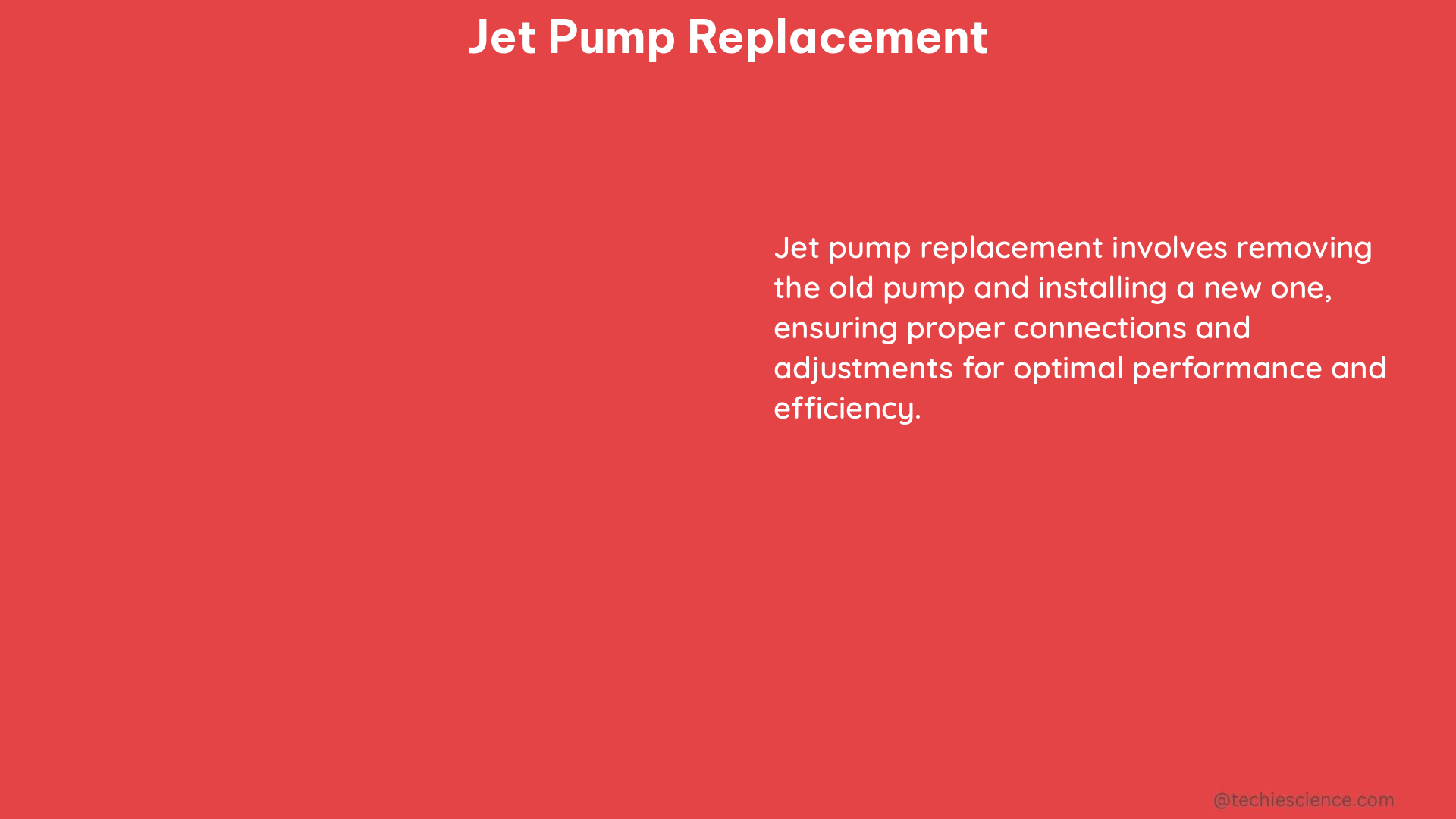When it comes to jet pump replacement, there are several critical factors to consider, including technical specifications, measurements, and quantifiable data. This guide will provide an in-depth look at jet pump replacement, focusing on advanced hands-on details, technical specifications, and a DIY approach.
Technical Specifications of Jet Pump Replacement
-
Pump Discharge Pressure: Jet pump performance depends primarily on pump discharge pressure, which is influenced by the gas/liquid ratio in the power fluid-reservoir fluid mixture returning to the surface. Optimizing this ratio to maximize lift is a complex process of fine-tuning the mixture by accounting for the gas/oil ratio in the reservoir fluid and the volume of power fluid entering the throat. The optimal pump discharge pressure can range from 1,000 to 3,000 psi, depending on the specific application and well conditions.
-
Nozzle Size and Surface Pressure: Balancing the power fluid rate, nozzle size, and pump discharge pressure is an iterative process requiring successive refined estimates. The optimal volume of power fluid is dictated by the size of the nozzle and the operating pressure of the surface pump supplying the power fluid. Typical nozzle sizes range from 1/8 to 1/2 inches in diameter, and the surface pump pressure can vary from 1,000 to 5,000 psi.
-
Power Fluid Injected Pressure: To achieve a targeted production rate of 5,000 bbl/d using a power fluid injected at a pressure of 4,000 psi, the pump intake pressure should be 2,000 psi. This pressure differential is necessary to create the necessary suction and lift the well fluids to the surface.
-
Operational Advantages: Jet pumps provide a variety of operational advantages, including versatility, over other forms of lift. They can operate for several years at a low risk of failure and with minimal maintenance requirements. They also tend to be more rugged and tolerant of corrosive and abrasive well fluids than other types of downhole lift systems. Jet pumps can typically handle flow rates ranging from 50 to 5,000 barrels per day (bbl/d).
-
Design Drawbacks: Jet pumps are prone to some design drawbacks, including the risk of cavitation—the formation of vapor cavities—at the entrance of the throat section caused by the rapid acceleration of the production fluids as they enter the pump body. As the fluid’s velocity increases quickly, fluid pressure can decline to its vapor pressure. Vapor cavities form at this low pressure, resulting in restricted flow into the throat. These vapor cavities may collapse as pressure rises in the pump, causing cavitation damage—erosion of internal pump parts. To mitigate this, the pump design must account for the specific fluid properties and flow conditions to ensure adequate pressure is maintained throughout the pump.
Jet Pump Replacement DIY

Replacing a jet pump can be a challenging task, but with the right tools and knowledge, it is possible to do it yourself. Here are the steps to follow:
-
Safety First: Before starting the replacement process, ensure that the power supply to the pump is turned off and locked out to prevent accidental start-up. Wear appropriate personal protective equipment (PPE), such as gloves, safety glasses, and steel-toed boots.
-
Remove the Old Jet Pump: Disconnect the suction and discharge pipes from the pump. Measure the pipe diameters and lengths to ensure the replacement pump will fit properly. Then, unscrew the pump from its mounting bracket and carefully lower it to the ground.
-
Install the New Jet Pump: Position the new pump in the same location as the old one, ensuring it is level and securely mounted. Reconnect the suction and discharge pipes, matching the diameters and lengths of the previous setup. Tighten all connections to the recommended torque specifications.
-
Test the New Jet Pump: Turn on the power supply and check for any leaks at the pipe connections or pump body. If there are no leaks, run the pump and check the pressure gauge to ensure that it is delivering the expected performance. Measure the flow rate and compare it to the pump’s specifications.
-
Adjust the Pressure Regulator: If the pump is not delivering enough water flow, adjust the pressure regulator to a higher setting. Refer to the manufacturer’s recommendations for the optimal pressure range and make incremental adjustments until the desired flow rate is achieved.
-
Perform a Final Inspection: Visually inspect the entire system for any signs of wear or damage. Check that all connections are tight and that the pump is operating smoothly without any unusual noises or vibrations.
By following these steps and adhering to the technical specifications outlined, you can successfully replace a jet pump and ensure its optimal performance and longevity.
References:
– The Defining Series: Jet Pumps – SLB. (2016-11-02). Retrieved from https://www.slb.com/resource-library/oilfield-review/defining-series/defining-jet-pumps
– About to replace jet with submersible pump. (2014-04-13). Retrieved from https://terrylove.com/forums/index.php
– deep-well jet pump that will not build pressure – DoItYourself.com. (2023-10-22). Retrieved from https://www.doityourself.com/forum/wells-sump-pumps-septic-sewage-systems/644989-deep-well-jet-pump-will-not-build-pressure.html
– Jet pumps – Grundfos Product Center. Retrieved from https://product-selection.grundfos.com/products/jet-pumps
– PRODUCTS – Red Lion Pump. [PDF] (n.d.). Retrieved from https://redlionproducts.com/media/69876/996740_red-lion_cleanwater_take_one-5-.pdf

The lambdageeks.com Core SME Team is a group of experienced subject matter experts from diverse scientific and technical fields including Physics, Chemistry, Technology,Electronics & Electrical Engineering, Automotive, Mechanical Engineering. Our team collaborates to create high-quality, well-researched articles on a wide range of science and technology topics for the lambdageeks.com website.
All Our Senior SME are having more than 7 Years of experience in the respective fields . They are either Working Industry Professionals or assocaited With different Universities. Refer Our Authors Page to get to know About our Core SMEs.